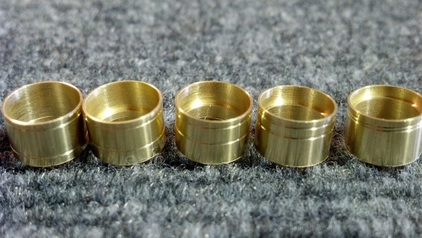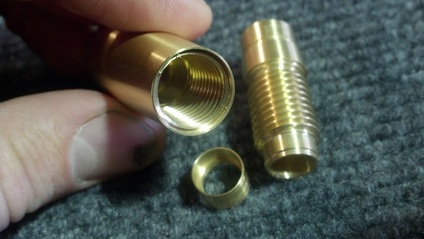 Picking up where I left off in part II, let's explore Impedance and Mouthpiece Gap adjustments available within the AGR System. Some of you have read my previous entries on Mouthpiece Gap, but if you missed them it may be helpful to check out the following pages on my website and blog: Mouthpiece Gap I Mouthpiece Gap II Mouthpiece Gap Solutions Survey of 31 Mouthpieces (Gap) A quick review of my research and development on the subject of mouthpiece gap reveals the following discoveries and information assets: - Recognizing venturi and gap as crucial components of custom fitting trumpets, I have incorporated these into my line of instruments since 2001. - Having measured and adjusted gap with various client mouthpiece variations over one thousand times, my notes on client preferences and experiences have been the basis of my current recommendations on gap, venturi and the AGR design. - My system of measuring venturi and gap with custom tools and inserts is available to all players today allowing anyone to fine tune gap without the need to retrofit the instrument. - The Gap Solution Kit introduced last summer has been very well received with almost 200 sets sold to individual players. The feedback received from these clients has influenced the final design of the AGR System. - The new 5MM Modular Mouthpiece System was designed to offer a gap solution utilizing a series of shanks of various lengths. This allows the player to choose the correct shank length to optimize gap and impedance on any horn. It may be obvious that I've been slightly obsessed with gap for some time. But in reality, this is something I never think about in my own playing. I have used a zero gap setting for so many years that I truly never think about this variable and this is my goal for my clients as well. There is freedom in finding that balance between slotting and flexibility, which rarely occurs without some exploration and effort. But once you find it, accuracy, intonation, wide intervals and flow remain consistent as long as your setup doesn't change. So the first goal is to find optimum gap and the second is to keep this setting with all mouthpieces and instruments. This may sound simple, but achieving these goals can drive some players crazy! And this is why I developed the Adjustable Gap Receiver. Okay, some of you didn't read my previous entries on gap so here's a quick review. If you ignore gap entirely, you are missing out on some serious advantages that people around you may be experiencing. These include greater flexibility and slotting especially in the extreme edges of your range. Can you easily slur from low C to high C? How about from pedal C to double high C? If so, then your setup may be close to optimum. But if you hit lots of notes between wide interval slurs, this could be a sign that your gap setting does not coincide with your style of aperture control and embouchure. Locking in too hard on the partials below your target is a sign that you have too much gap. Sliding around and missing the note altogether is a sign that you need more gap. Remember, gap is the distance from the end of the mouthpiece shank to the beginning of the leadpipe. This space is a wider diameter than the mouthpiece and leadpipe edges, which creates a variance in impedance and in turn changes the feel of flexibility and slotting. I personally use zero gap, meaning there is no space between my mouthpiece and leadpipe on my Summit One to intentionally remove this impedance change. However, the vast majority of brass players are accustomed to varying degrees of impedance variation due to gap so finding the balance that works best for you should be the primary goal. The AGR Inserts are individually numbered and precision machined to create a complete series of gap options. These are logically numbered based on their real measurements. Insert #2 offers a theoretical gap of .02" or two one hundredths of an inch. Likewise, #4 creates .04" gap, #6 = .06" and so on. The largest insert is #18, which creates the most gap, but due to the constraints of the system it measures a maximum gap of more than .180". This is the only AGR Insert that does not follow the previous rule only because there is no more insert wall to remove at this point as it approaches the other end of the tube length. This insert is included with the AGR for clients using Schilke mouthpieces as these tend to have a longer than usual shank length. Understanding how to "read" the lines on the AGR Inserts is important when experimenting with various gap settings. I have labeled each Insert with two small lines on the outside diameter that directly represent the shoulder relief on the inside of the tube. The first line represents the theoretical length of the mouthpiece shank end. The second line represents gap distance. For example, the smallest insert is #1, which has two lines only .01" apart. This represents the theoretical gap created as the inside shoulder has been reduced by .01". This may be confirmed with a caliper, but the easiest technique is to line all of your inserts in a row from largest to smallest as in the photo above. Keeping your inserts in order speeds up the process by which you experiment with them. I highly recommend labeling each insert with a colored dot or name written in permanent fine tip marker. If you find that the #4 insert is preferable when playing your Monette B2, then write B2 on that insert. Do the same for each mouthpiece you use regularly so that you no longer need to remember the insert numbers. In the case of using many mouthpieces, it may be necessary to number the inserts and keep a record of your preferences in a simple chart. For those of you using the 5MM Modular Mouthpiece System, all of this is simplified so long as your various backbores are ordered in the same length. I'll explain more about the 5MM and how it was designed to work with the AGR in a future entry. For your reference, I have found that Inserts 2-5 work well with Monette mouthpieces, 8-14 with Bach and Yamaha, 16-18 with Schilke and 1-18 with the 5MM System. Included with every AGR Retrofit Kit and Summit trumpet are five inserts; #18, #16, #12, #8 and #4. The photo above shows the inserts arranged in the same order. You may fine tune your gap/impedance setting with any custom size available for at minimal cost. In my next blog entry, we will explore changing air flow and Venturi with the AGR...
0 Comments
 As mentioned in part I of this blog topic, the Adjustable Gap Receiver combines three simple concepts into one new component of the brass instrument. These are Efficiency, Regulated Air Flow and Consistent Impedance. Let's explore each of these concepts individually to better understand the advantages gained by fine tuning your trumpet setup. Efficiency is really the backbone of my research and development over the past twenty years. The AGR is considerably more efficient than any standard receiver thanks to the design of all three components; the mount, insert and receiver. Energy is lost in the standing wave of a brass instrument much like electricity is lost in low gauge, poorly insulated wiring. A thin mouthpiece receiver and mount will easily vibrate when an anti-node (high pressure area) is located at the mouthpiece receiver. Considering the receiver is near the end of the instrument, there is almost always an anti-node at this location converting your sound wave into motion. This essentially robs energy from your sound introducing instability on various partials of the overtone series. The AGR is available in various shapes and sizes allowing you to fine tune efficiency. Looking for the most efficient setup possible? The 3/4" cylindrical version (R2) the most energy efficient option meaning your wide interval leaps will lock in solid at any dynamic level. Want more physical feedback in the form of vibration in the leadpipe? Even though the 5/8" taper version (R4) is the least efficient, it offers more feedback especially when playing in loud environments. My personal favorite is the 3/4" tapered version (R1) which is included with every new Summit trumpet built since September of this year. I have owned and tested all of the various receiver systems produced in the last 100+ years, so far as I know. This includes three notable versions that attempted to address gap adjustment. The Courtois receiver was a step in the right direction with a set screw to lock in the distance from the leadpipe to the mouthpiece. However it was clunky and would get stuck all of the time. The second version was produced by a great trumpet builder and was used on at least two different brands, but wasn't much different from the Courtois iteration. The third was made by Adams, which is a percussion company that decided to start producing trumpets. Their version looks really nice and has a smooth feel to the geared wing nut. Again, this is another step in the right direction. But all three are missing my first requirement, Efficiency! Not to mention none of them offered a simple way of knowing the best gap setting with multiple mouthpieces, or even one mouthpiece. On the Adams, it is very easy to set the gap, yet just as easy to move it out of place and wonder why slotting and flexibility feels out of balance. On the other two, setting the gap is more difficult and changing to a different mouthpiece required a lot of adjusting all over again. My hat is off to all three manufacturers for moving in the right direction. These companies are innovators in the true sense of the word and their efforts inspired me to create the AGR Retrofit Kit. The AGR Retrofit Kit will allow anyone to experience the benefits of improved efficiency while fine tuning mouthpiece gap resistance AND impedance AND venturi air flow. If there were something more I could fine tune within this component, I would have designed it to do that too. Back to how efficiency was designed into the AGR, I designed the mount to be soldered directly to the leadpipe with almost no clearance space. This was intended to prevent air pockets when installed, which I have discovered on new and vintage horns literally hundreds of times. An air pocket or unsoldered area of a receiver mount directly causes energy loss in the standing wave. Almost every Bach Stradivarius I have ever disassembled has had this problem. When installing the AGR Mount, you must lightly sand down the outside diameter of the leadpipe end until it fits perfectly. Assuming you flux everything and solder properly, this will completely prevent air pockets within the joint. There's more, the AGR Mount was designed to be relatively thick and the threads are a very special shape that maximizes surface area contact with the Receiver when screwed together. In fact, the surface area of this thread design is around five times greater than is produced with a standard 60 degree thread tool. This ensures the AGR does not set into motion regardless of the amplitude of the anti-node directly beneath. I cannot recall the last time I cracked a wide interval slur in a performance and this design only reinforces my integrity as a player. Yep, there's even more to how I integrated efficiency into the AGR. The key to fine tuning the venturi, impedance and gap is the Insert that is held in place precisely between the Mount and the Receiver. I'll include some drawings in the next entry to illustrate this design. But the wall thickness of the inserts is a crucial piece of the efficiency puzzle and I designed these right. Sure it has taken me half of my life to finally finish what I started on this component, but taking my time to do it right has really paid off, for myself and hopefully for you. My next entry will explore Impedance and Mouthpiece Gap, which are in a sense the same thing...  I've been experimenting with Mouthpiece Gap and Venturi variations for many years to better understand the benefits of fine tuning these parameters of the modern trumpet. It has been a dream of mine for nearly twenty years to create a way to adjust gap and venturi on the fly while retaining high standing wave efficiency. I cannot believe so many years have passed developing this one component. Regardless of my snail-like pace, I have never been more excited to introduce an innovation to the world of brass players. Some of you are reading this wondering how in the world mouthpiece gap, venturi and those brass items in the photo could possibly affect the playability of a trumpet, trombone, french horn, etc. You may be skeptical of the entire concept which is perfectly understandable considering the lack of information available on this subject. But I'm here to reassure you that you are not wasting your time here. In fact, you could be on to the greatest single improvement to your playing available anywhere today, at the dawn of the year 2014. I suspect that much of the knowledge I have gained on the subject of brass instrument acoustics was already known to many of the craftsmen building trumpets before World War II. I personally believe that WWII was the end of an era in brass instrument manufacturing that may never again be rivaled in terms of the number of men and women plying their trade as experts in this field. Today's custom trumpet market is very different and in many ways much more exciting. But far too many supposed experts in my field today know very little when compared to the forward thinking innovators at Conn, Selmer, Olds, Bach, Holton, King, Martin and many other iconic manufacturers prior to WWII. When they left their workbenches in a joint effort to win the war, their knowledge, wisdom, patience, virtue, heart and soul left with them. There were of course many fine instruments built after this period, but after careful measuring, testing, playing and observing post WWII manufacturing from the finest companies, I believe this was in fact the end of the first golden age of brass instrument design and manufacturing. With that said, we are now witness to a second golden age with more innovators, entrepreneurs and performers taking chances to explore new sounds than every in history. Combining numerous emerging technologies in electronic sound engineering, recording, metallurgy, manufacturing, measurement and testing with real world musical performance in literally all genres, we are poised to experience what future generations will read about in history books. I believe we are at this very moment reinventing brass instruments and what will emerge from the next twenty years will in many ways determine live brass acoustic/electronic performance for the next fifty or more years. The next few years are as pivotal to trumpet as Les Paul's innovations were to the guitar. Today is the most exciting time to play a brass instrument and I have a feeling we'll finally give the electric guitar a serious run for the money! So what's all this about AGR? The Adjustable Gap Receiver combines three simple concepts into one new component of the brass instrument. These are Efficiency, Regulated Air Flow and Consistent Impedance. There have been other receivers produced by various manufacturers that did in fact change the distance from the end of the mouthpiece to the beginning of the leadpipe. However, these designs failed to address all three factors of the mouthpiece receiver affecting playability. When I design a solution to a real world problem, my intent is to solve the ENTIRE problem, not just one piece of the puzzle. I suspect previous attempts by other builders fell short due to a lack of knowledge and understanding. This is likely a result of the corporate structure in which these manufacturers operate as the designer/engineer, machinist, assembly-man and musician are all different people who perhaps met once in person. It is possible that the people responsible for new innovations have never had a conversation face to face in the same room. This is where I have the advantage. Considering I play trumpet every spare moment between designing, machining, assembling, testing and measuring trumpets, I not only have a more comprehensive view of the problem, but I can bring life to a new idea in a matter of hours and test it myself. |
Jason Harrelson
Inventor, Musician, Educator and Founder of Harrelson Trumpets, Trumpet Momentum and Harrelson Momentum. Archives
July 2024
|

 RSS Feed
RSS Feed
